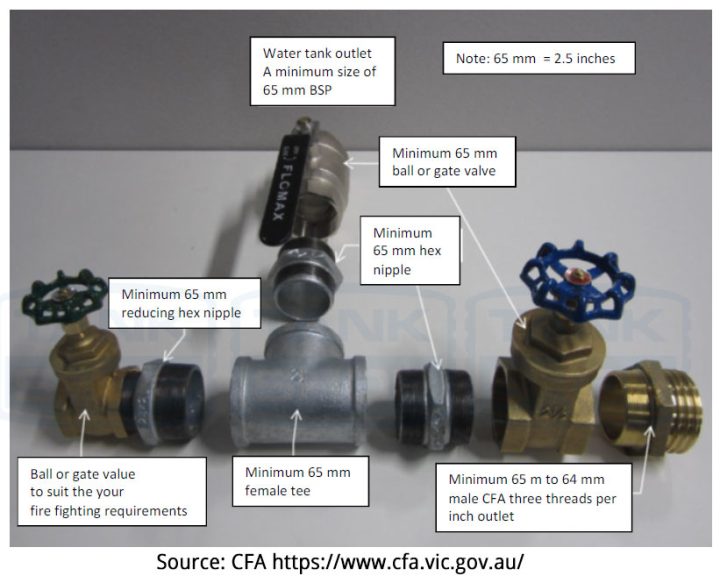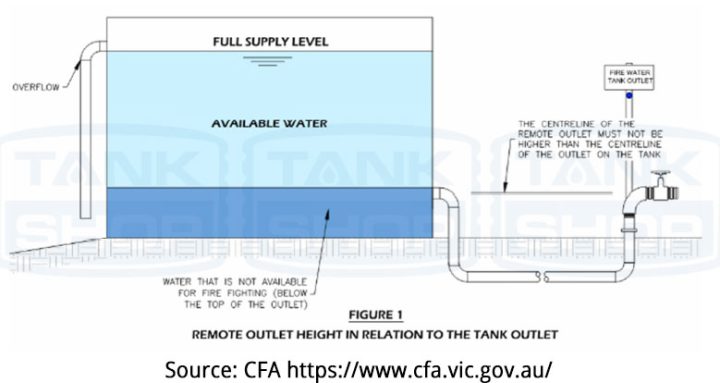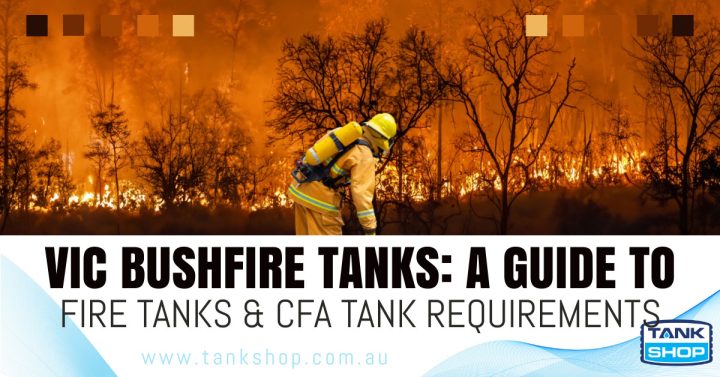Fire-Fighting Water Tanks, Government Compliance
VIC Bushfire Tanks: A Guide to Fire Tanks and CFA Tank Requirements
Living in Victoria means bushfire preparation isn’t just smart—it’s essential for protecting your family and home. Having a properly equipped water tank on your property can make all the difference when fire threatens, providing firefighters with the water supply they need to defend what matters most to you. This comprehensive guide will walk you through the Country Fire Authority (CFA) requirements for Fire-Fighting Reserve Tanks, helping you understand exactly what you need to keep your property safe and compliant.
Why Do You Need a Fire Water Tank?
In bushfire-prone areas, having a water tank on your property can be crucial. During major fire events, mains water supply is often cut off, so having your own water reserve gives firefighters immediate access to the water they need to protect your home.
The CFA has specific rules for these tanks to ensure they work effectively in emergencies. These rules cover volume, access, and markings. It’s also essential that the water tank and outlets are made from materials that won’t combust or melt during a fire.
Find below a summary of CFA’s Fire Tank Requirements. For full details, refer to Clause 53.02 Bushfire Planning of Victoria Planning Provisions.
How Much Water Do You Need for Fire-Fighting Reserve?
All new developments in Victoria must incorporate a water tank for fire-fighting purposes. The amount of water you need depends on the size of your property – refer to table below.
| Lot size (square meters) | Fire Tank Capacity (litres) |
|---|---|
| Less than 500 | 2,500 |
| 500-1,000 | 5,000 – if hydrant available |
| 500-1,000 | 10,000 – if hydrant not available |
| 1,001 and above | 10,000 |
- Properties under 500m²: You need at least 2,500 litres of fire-fighting reserve.
- Properties 500 to 1000m²:
- If you have a hydrant available (located within 120m) you need at least 5,000 litres.
- If you don’t have a hydrant available, you need at least 10,000 litres.
- Properties over 1000m²: You must have at least 10,000 litres of water available for firefighting.
These requirements apply to homes (dwellings), offices and retail premises. Higher risk buildings (where larger groups of people gather, such as child care centres, schools, hospitals, etc) require a 10,000 litres per 1500m2 of floor space, to a maximum of 40,000 litres.
What Kind of Tank Should You Use for Fire-Fighting Reserve?
To ensure your water supply is accessible and won’t be burn or melt during a fire emergency, your fire-fighting reserve must be stored in an above-ground tank, made of non-combustible materials like concrete or steel.
For properties that require a 10,000 litre water tank for fire protection, you must also provide special fire authority fittings and access. The water tank must be:
- Easy to find: easy to spot from your building, or you need to put up clear signs that the fire authority approves of.
- Close to your building: within 60m of the outside edge
- Easy to access: the tank’s water outlets must be within 4m of a driveway or access road, with nothing blocking the way
- Fitted with a CFA Fitting: You need a separate 65mm ball or gate valve and a special CFA coupling.
This is essentially about making sure firefighters can quickly find and use your water tank in an emergency. These technical specifications ensure their equipment will connect properly and there’s enough water flow for effective firefighting.

For smaller properties (less than 500m²), you do not need any special fittings or to provide access to the fire authority to your fire-fighting reserve water supply. Your tank may be placed anywhere on the property.
Using a Remote CFA Outlet
For properties that require a 10000L fire tank, if you are unable to install your water tank in a location where the fire truck can access it, then you can set up a Remote CFA Outlet. This is a separate CFA tap set up in another part of your property that is connected to your fire-fighting reserve tank.

The main purpose of a Remote CFA Outlet is convenience and accessibility: it allows firefighters to access water from your tank without having to physically reach the tank itself, which might be in a difficult location or obstructed by other structures.
Comparison between CFA Tank Fitting and Remote CFA Outlet
| Feature | CFA Fitting on Tank | Remote CFA Outlet |
|---|---|---|
| Location | Attached directly to the water tank | Located away from the water tank (remotely positioned) |
| Connection | Standard connection point on the tank | Connected to the tank via pipes/plumbing |
| Access | Allows immediate access to water from the tank itself | Provides access to the tank’s water supply from a more convenient or strategic location |
| Main Purpose | Direct tank access | Enhanced convenience and accessibility for firefighters |
For more information on Remote CFA Outlets, refer to CFA’s fact sheet:
Use of Remote Outlets on Water Supply Tanks in The Bushfire Management Overlay (PDF).
What is an Occupant’s Outlet?
The CFA regulations require that fire-fighting reserve tanks include a separate outlet specifically for the property owner’s use during fire emergencies. It’s important to note that this outlet is solely for firefighting purposes by the occupants—it’s not intended for everyday uses like garden watering or toilet flushing. This occupant’s outlet serves as your personal access point for filling buckets, connecting hoses, or operating pumps when defending your property. Like the CFA outlet, this can be installed directly on the tank or as a remote outlet in a more accessible location. The key requirement is that it must be easily accessible and simple to operate during the stress of an emergency situation.
Dual-Use Fire Tanks
If you want to maximize your water storage investment, consider a dual-use fire tank. This system allows you to harvest rainwater for everyday household needs while still maintaining your required fire-fighting reserve in a single tank.
The setup includes two separate outlets: your standard fire-fighting outlet at the bottom for emergency access, and an additional 25mm outlet installed higher on the tank. This elevated outlet lets you use the water above your designated fire reserve for regular household activities, while keeping your emergency supply untouched and ready when needed.
This approach gives you both CFA compliance and practical water storage in one efficient system. If you’d like to explore this option further, read our article on on Dual-Use Fire Tanks.
Ready to find the perfect tank for your property?
Our team at Tank Shop understands CFA’s Tank Requirements and are here to help you choose the right solution for your specific needs and location. Contact us today to discuss your requirements.



